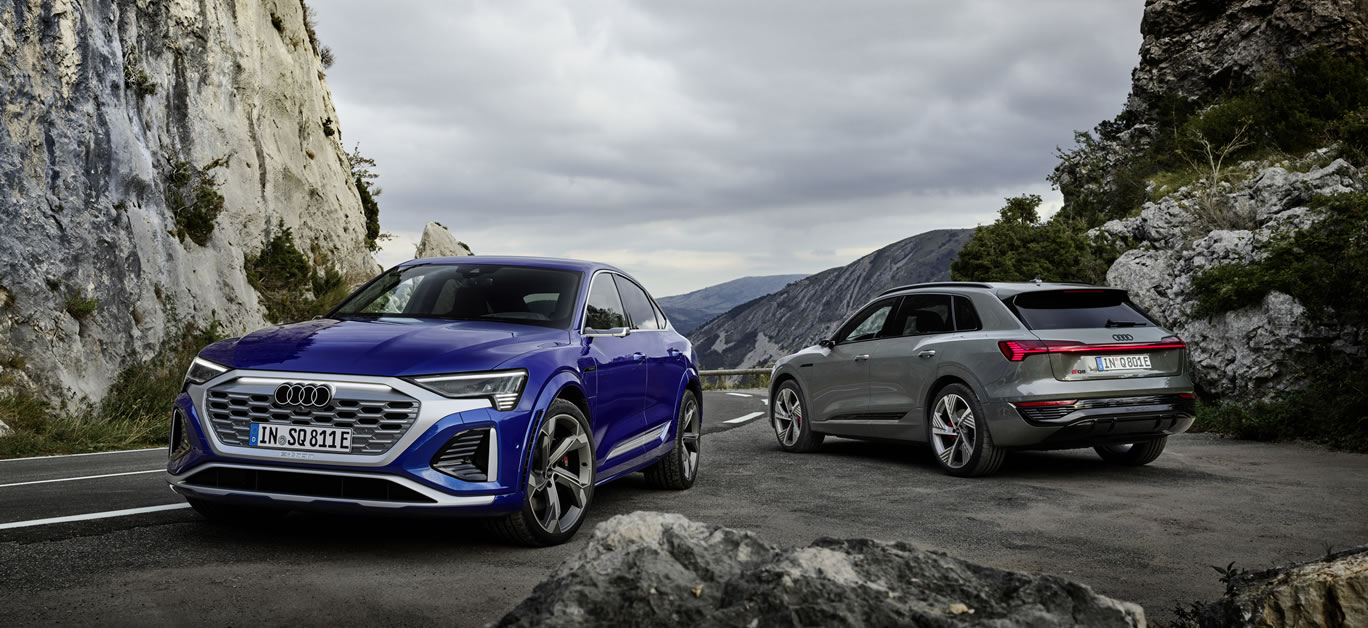Audi entered the age of electromobility in 2018 with the stunning and super to drive e-tron. Since then, the model has been setting standards in the electric luxury-class SUV segment. The introduction of the new Audi Q8 e-tron will build on the success story of this electric pioneer.
Since the introduction of the Audi e-tron, the company has been following a systematic electric roadmap. Its electric portfolio now comprises eight models and by 2026 will have more than 20. At that point, Audi will only be releasing fully electric models on the global market.
Distinctive exterior
By renaming this model the Q8, Audi is making a clear statement that the Audi Q8 e-tron is the flagship model among its electric SUVs and Coupe SUVs. The Audi Q8 e-tron and Q8 Sportback e-tron are immediately identifiable as fully electric models, marked out by the new front and rear designs that carry Audi’s electric design language forward. As a prestigious electric SUV model from Audi, the Q8 e-tron ushers in the new corporate identity with a two-dimensional design of the four rings on the exterior. The model lettering with an Audi logo on the B-pillar is a new feature.
Maximum amount of space and comfort
With a vehicle length of 4,915mm, a width of 1,937mm, and a height of 1,619mm for the Sportback and 1,633mm for the SUV, the Q8 e-tron offers a maximum amount of space and comfort. The SQ8 e-tron and SQ8 Sportback e-tron are each two millimetres lower and 39 millimetres wider. Its wheelbase of 2,928mm allows for plenty of legroom in the back seats, too. It has a generous storage volume of 569 litres for the SUV and 528 litres for the Sportback. There are also 62 litres available in the front storage area, the so-called ‘frunk’.
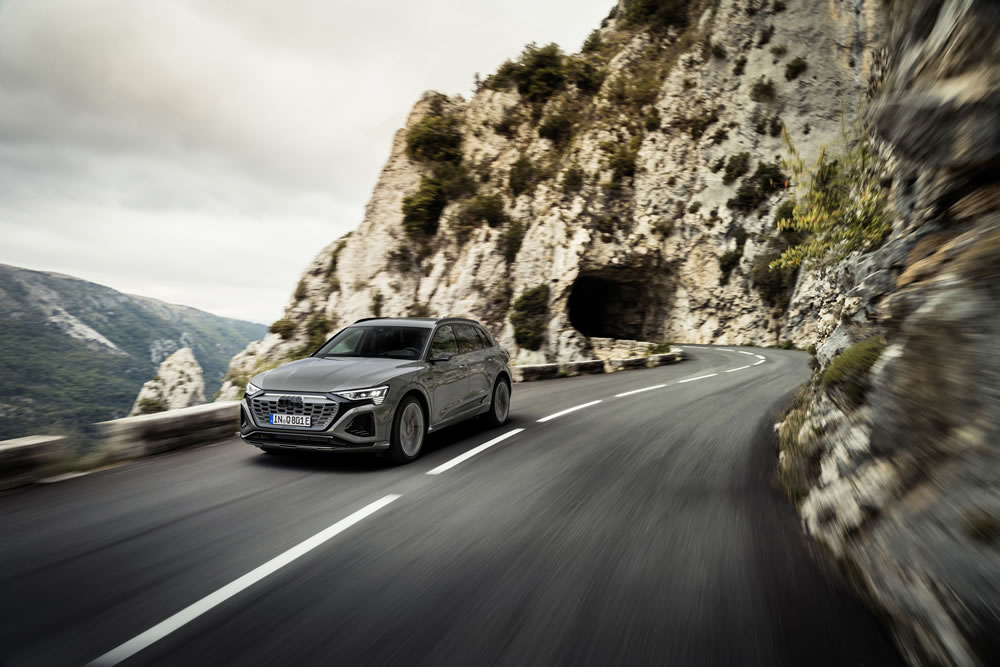
Three drivetrain variants
For both body shapes, three drivetrain variants with electric all-wheel drive are available. Driven by two motors, the base models of the Audi Q8 50 e-tron and the Audi Q8 Sportback 50 e-tron generate 250kW (340PS) in boost mode and 664Nm of torque, and they get a WLTP range of up to 281 miles (SUV) and up to 290 miles (Sportback) in UK versions.
Sitting above in the line-up is the Audi Q8 55 e-tron and Audi Q8 Sportback 55 e-tron, which are also driven by two electric motors. The models generate 300kW (408PS) in boost mode and 664Nm of torque. Their ranges are up to 330 miles for the SUV and up to 343 miles for the Sportback in the UK. The top speed, and that of the Q8 50 e-tron, is limited to 124mph.
The top-end Audi SQ8 e-tron and Audi SQ8 Sportback e-tron are driven by three motors. Their boost performance amounts to 370 kW (503PS) and 973 Nm of torque. The range of the S models is up to 284 miles for the SUV and up to 295 miles for the Sportback. Top speed is limited to 130mph.
More battery capacity and higher charging performance
The battery of the Q8 50 e-tron has a storage capacity of 89kWh (95kWh gross), while the more powerful versions of the Q8 55 e-tron and SQ8 e-tron boast a battery storage capacity of 106kWh (114kWh gross). Thanks to an adjustment to the battery management system, the battery capacity usable for customers has increased as well.
At a high-powered charging station, the Audi Q8 50 e-tron reaches a maximum charging performance of 150kW. With the Q8 55 e-tron and SQ8 e-tron, the maximum charging performance increases to up to 170kW. The larger battery can be charged from 10 to 80 percent during a 31-minute charging stop – under ideal conditions, this corresponds to a range of up to 240 miles.
At an AC charging station or wallbox, the Audi Q8 e-tron charges at up to 11kW. Audi offers an optional AC charging upgrade of up to 22kW. Under ideal conditions, the Audi Q8 50 e-tron can completely charge in around nine hours and 15 minutes on a 11kW power source and in around four hours and 45 minutes on a 22kW power source. The Q8 55 e-tron’s larger battery will charge in around 11 hours and 30 minutes at 11 kW and six hours at 22 kW.
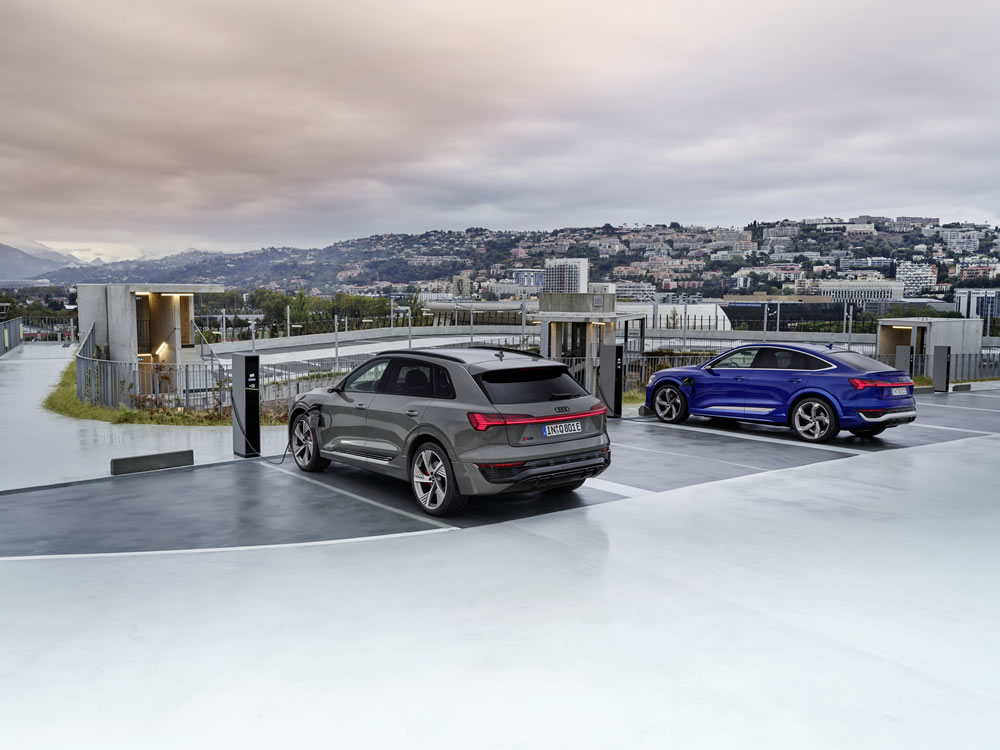
Revised rear-axle motor and electric torque vectoring for better dynamics
For the new Audi Q8 e-tron, the asynchronous motor on the rear axle has been modified. Instead of 12 coils generating the electromagnetic field, there are now 14. The motor consequently generates a stronger magnetic field with similar electricity input, which allows it to generate more torque. If this increase in torque is not required, the electric motor then consumes less energy to generate the required amount of torque. This lowers consumption and increases range.
The three-motor set-up was refined for the new SQ8 e-tron. It comprises a 124kW (168PS) electric motor on the front axle and two electric motors on the rear axle, each driving one wheel, with 98kW (133PS) of output. This allows for an output of up to 370kW (503PS) in boost mode. The torque can be distributed across both rear electric motors between both wheels within a split second.
Balancing act between comfort and sportiness
The new Audi Q8 e-tron comes standard with an air-spring suspension with controlled shock absorption. The height of the car body can be varied by a total of 76mm, depending on the driving situation. To optimise the lateral dynamics of the vehicle, its air-spring tuning was adjusted. Moreover, its electronic stability control (ESC) will allow for even more adjustability – especially in tight corners. The Audi Q8 e-tron handles these with noticeably more agility thanks to its revised progressive steering.
The gear ratio of the steering system was changed so that the steering responds much more quickly, even when making delicate movements. The effect of the direct steering ratio is supported by more rigid suspension bearings on the front axle. Steering movements are thus transmitted to the wheels more directly, and feedback from steering reactions is improved as well. All the chassis control systems were adjusted, but they remain balanced and perfectly attuned – true to the Audi DNA.
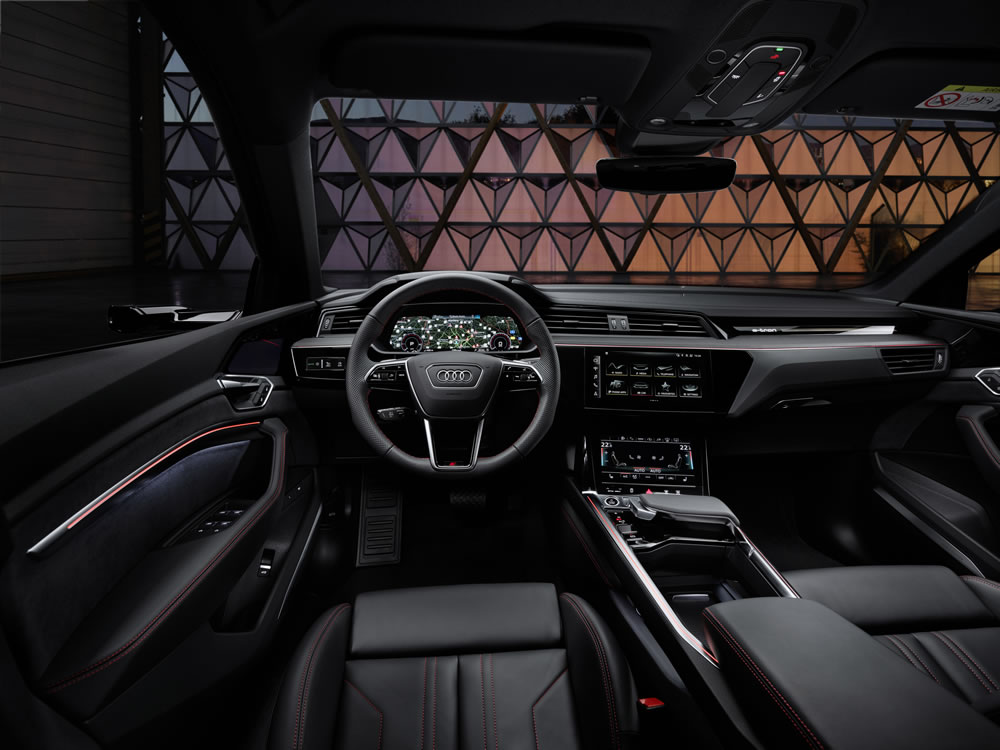
Further improved aerodynamics
Aerodynamics was a top priority. A focus on this aspect resulted in a reduction of the drag coefficient from 0.26 to 0.24 cw for the Q8 Sportback e-tron and from 0.28 to 0.26 cw for the Q8 e-tron. The wheel spoilers mounted on the underbody help divert airflow around the wheels. The spoilers on the front axle were enlarged, and the Audi Q8 Sportback e-tron now has spoilers on the rear wheels as well.
With the SQ8 Sportback e-tron, spoilers are only mounted on the rear axle. In the area around the grille, this is the first time an Audi model has had a self-sealing system in addition to the electric shutters that automatically close the radiator. This system further optimises the airflow at the front of the car and prevents undesired losses.
Convenient parking with remote park assist plus
There are around 40 driver assistance systems available in the Audi Q8 e-tron. Up to five radar sensors, five cameras and 12 ultrasonic sensors provide environmental information that’s then analysed by the central driver assistance control unit.
Remote park assist plus is a new feature, which will be available to order later in 2023. It allows the Audi Q8 e-tron to manoeuvre into even the tightest parking spaces. Customers can control the parking procedure through the myAudi app on their smartphones. When the car reaches its final position in the parking space, it automatically switches off, puts on the parking brake, and locks the doors. To leave the parking space, the Q8 e-tron is powered on through the myAudi app, and then the vehicle moves out enough for comfortable entry.
Digital Matrix LED headlights
Top spec Q8 e-trons come with digital Matrix LED headlights. While driving on the motorway, the orientation light marks the car’s position in the lane and helps the driver remain securely in the centre in narrow spaces. Three other new features include enhanced traffic information, the lane light with a direction indicator and the orientation light on country roads.
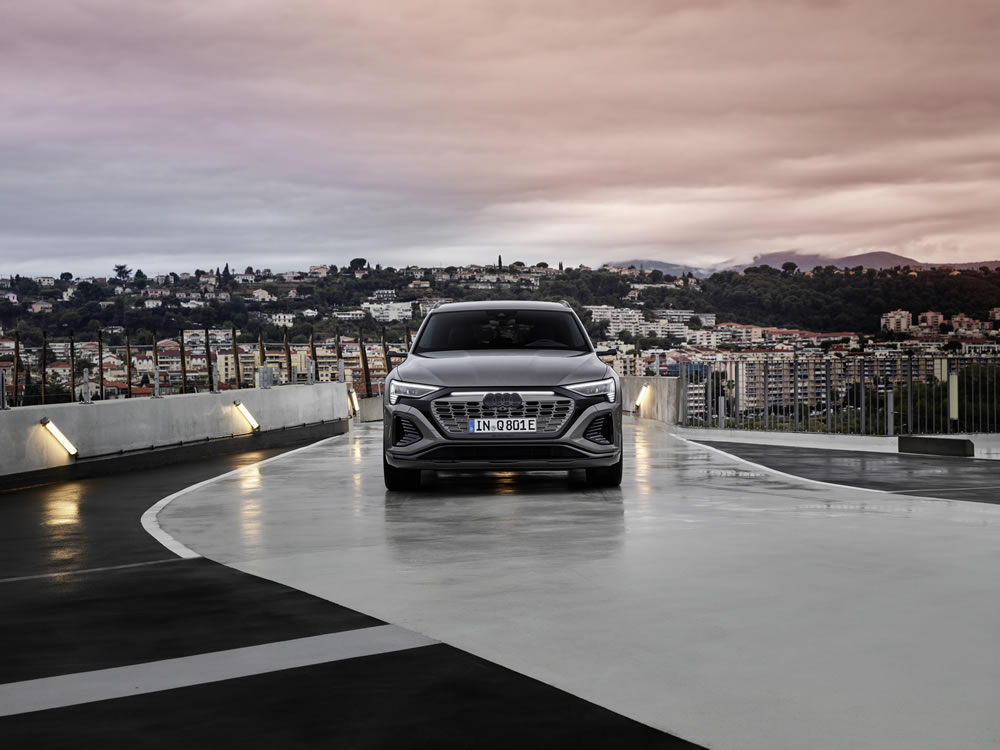
High-resolution touch displays and voice control
Like all luxury-class Audi models, the Q8 e-tron uses the MMI touch response operating system. Its two large high-resolution displays – the upper 10.1-inch display and the lower 8.6-inch display – replace nearly all conventional switches and knobs. However, a lot of features can be activated through natural voice control.
The digital display and operating concept in the Audi Q8 e-tron is rounded out by the standard Audi virtual cockpit with full HD resolution. Specific graphics show all the important aspects of electric driving, from charging performance to range.
Materials from recycling processes
The Audi Q8 e-tron will be certified as net-carbon-neutral for customers in Europe and the USA. Audi also uses recycled materials for some components in the Audi Q8 e-tron. These materials, treated through a recycling process, reduce the number of resources used and ensure a closed, efficient and sustainable material loop.
In the interior of the Audi Q8 e-tron, Audi uses recycled materials for insulation and damping, as well as for carpeting. The decorative inlay above the display, called the tech layer, is available with a new anthracite-coloured technical material that’s partially composed of recycled PET bottles.
On certain specifications, the sport seats are upholstered in synthetic leather and the microfiber material Dinamica. Dinamica is made from up to 45 per cent polyester fibres that are manufactured from recycled PET bottles, used textiles and fibre residue. In contrast to previous microfiber quality, the production of Dinamica is also solvent-free – another contribution to environmental protection.
For further information, visit: audi.co.uk.












